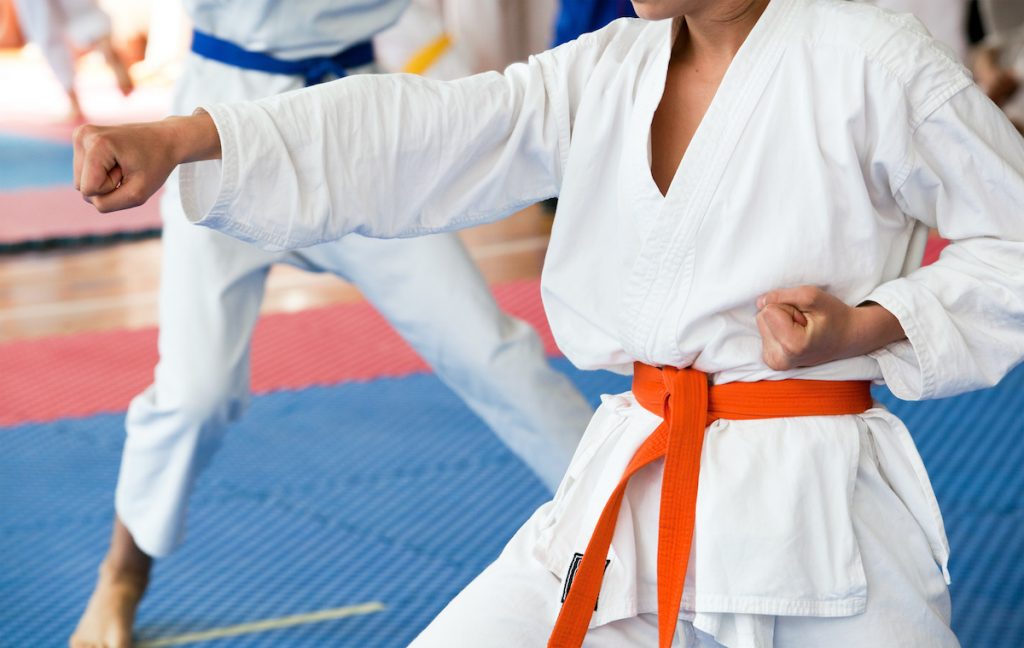SwiftKick Martial Arts, San Diego, follows the traditional practice of working towards higher levels indicated by belt color. The inclusive programs, designed intentionally to incorporate an incredible repertoire of skills and techniques, continue to be the most well-rounded martial arts program in San Diego County. Combining elements of MMA, Kickboxing, Jiu-Jitsu, Krav Maga, Karate, Taekwondo, and Kung Fu, Brian Cowell has masterfully designed age-appropriate programs for SwiftKick and has proven repeatedly successful. This blog aims to shed a little light on the different ranks, belt colors, and the alarmingly effective stripe system used by Brian and his team of expert instructors.
Belt color, in general, shows the level of expertise achieved in martial arts. The belts progressively get darker as skills increase; the Black belt is the highest achievement. The combination of mental discipline and physical ability of techniques and sequences become more substantial considerations when working towards the next belt color. All this to say, a 3-year-old with a white belt will have different expectations than a 14-year-old working towards a purple belt. It is important to note that brown and black belts have different degrees, and multiple black belts can be achieved in various disciplines within martial arts. More to come on this in next week\’s blog with a specific focus on black belts since this has numerous aspects worthy of their own blog.
White Belt
The white belt is the beginner belt for all students. Those basic skills are eventually mastered as the programs are designed to incorporate both the mental aspects of martial arts training and the basic skills required to build upon for higher levels. Several self-defense techniques must be mastered before moving towards the yellow belt.
Yellow Belt
The yellow belt is for students displaying consistent mental discipline, and the focus shifts slightly to the physical skills and conditioning.
Orange Belt
A higher level than yellow is the orange belt. As you notice, the color increases in darkness, as is true from yellow to orange. Orange is for students showing readiness to move beyond self-defense and begin learning simple and basic offensive moves.
Purple Belt
The purple belt begins the intermediate training, working towards the green belt. As instructors see evidence of readiness to increase skill range and complexity of sequences, they move up to a purple belt.
Green Belt
Achieving the green belt shows a student is ready to work towards brown belt goals. This is an entire belt level designed for intermediate skill levels. Typically, students are showing mastery in more than 200 skills to show readiness to love to the next belt, which is the brown belt.
Brown Belt
The brown belt’s significance should not be overlooked. Brown belt achievement begins with third-degree and works towards first-degree within this belt color. The brown belt is broken up into different stages as students must continually show increased knowledge of skills, mastering them, and intense mental focus and discipline. Typically, the brown belt takes up to three years of training at this level. Students achieving first-degree brown belts must show proficiency in all techniques learned to that point.
Black Belt
This incredible achievement can take years to accomplish has many interesting elements and facets; it warrants its own blog – check back next week!
Stripe Significance
Stripes are standard in Taekwondo and show significant milestones met to pass to the next belt color. These stripes are part of Brian’s incredible program design to signify short-term goal accomplishment. These stripes prove to be effective in being as a sign of progress and encouragement to persevere. Especially with younger students in the Explorer and Pathfinder programs, these stripes are an incredible tool to manage unwanted behaviors and build focus and discipline.
As rank in the belt is achieved, the stripe demands increase. Earning stripes and belt colors will always vary from student to student. Learning patience and work/reward is another benefit for those training in martial arts. Martial arts are individual sports.
Commonly seen in SwiftKick’s youth programs are black stripes on the end of the belt. Black stripes typically indicate 100% effort, focus, respect for self and others, discipline, and ability to execute learned moves accurately and with speed and appropriate energy. There are many facets to striping, so maybe a blog for a future date or ask Brian or one of his master instructors for more details!
To check out what SwiftKick offers in North County, visit SwiftKick.com for locations and sign up for a free class. There are programs for all ages and levels, so if you are new to the area and already have some training, SwiftKick is a wonderful place to make your new dojo!
Programs include:
Explorer for children (3-5)
Pathfinder for children (6-11)
Impact for teens (12+)
Champion for adults (18+)
Self-Defense
Fitness
Private Training…and more!

